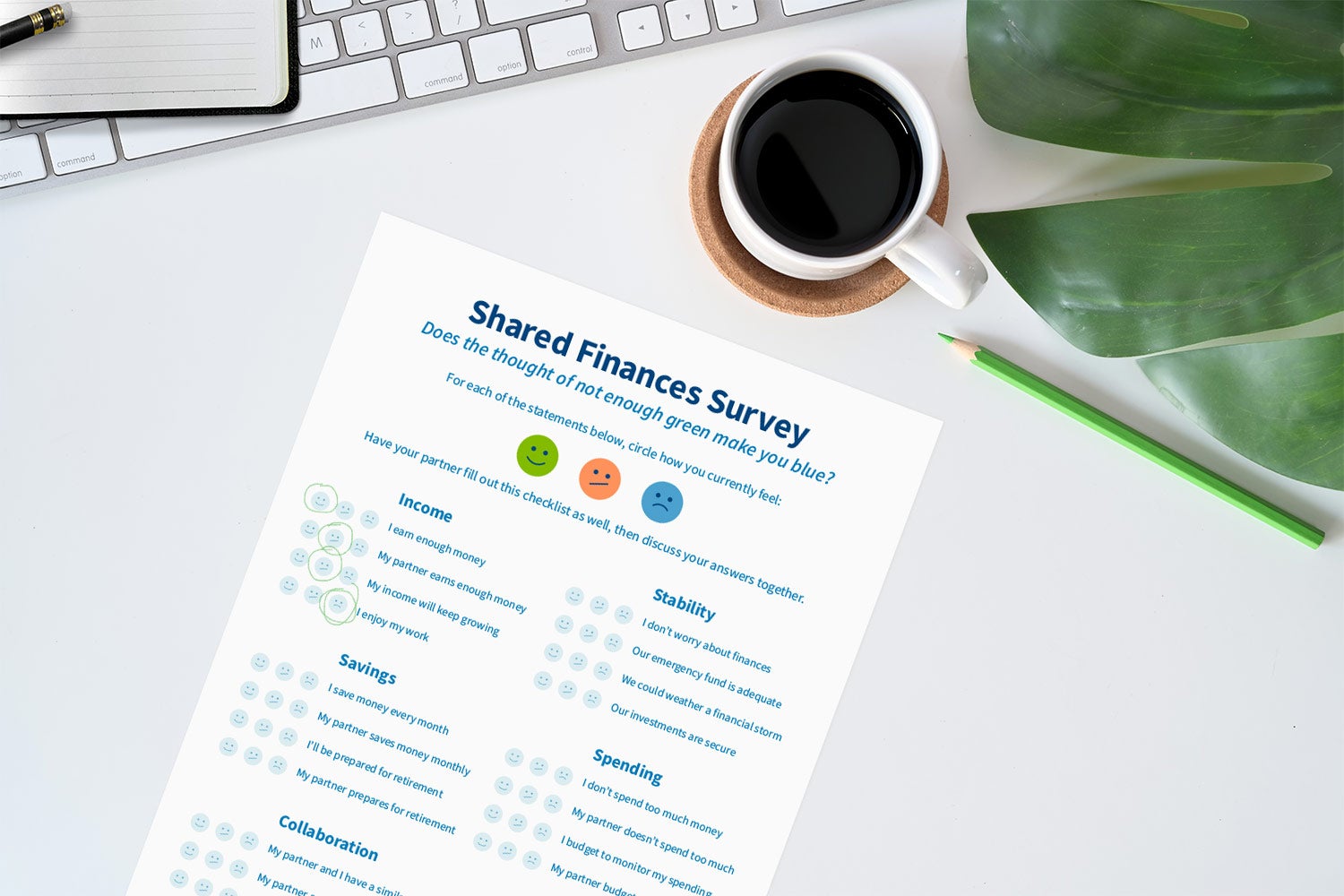
Disclosure regarding our editorial content standards.
Romantic partnerships can be incredibly rewarding—filled with love, mutual support and affection. Even the strongest relationships face challenges, though, and it’s the response to these challenges that can bring you even closer to your partner.
Among the hardest decisions to make: How are you going to deal with finances? For committed couples or married partners, deciding how to handle shared finances can lead to difficult discussions—differences between each partner’s approach to money are surprisingly common.
Fortunately, there are many ways to make money work in your relationship. And with a solid plan for your finances, you can get back to focusing on what makes your relationship amazing. Read on to learn what you need to think about before making a plan to share finances, as well as a number of different approaches that might work for you.
Best ways to share finances
While there is no one single “best way” to share finances in a relationship, there are several well-tested methods that you may change to fit your needs. Each of these approaches have advantages and disadvantages, and each may work better for different kinds of couples or personal finance philosophies.
It’s important to find an arrangement that makes both you and your partner happy. Take any of these approaches as a starting point to have a conversation about money with your partner as you work out the best way to share finances.
The all-in approach
With the all-in approach, you will join every aspect of your finances. Typically, this would mean that you both share all of your accounts (checking, savings, credit cards, etc.) and work together to pay bills, save money and invest for retirement.
The all-in approach requires a high level of trust, and it often involves a lot of work to get all of your accounts joined. Also, fully sharing finances usually means you need a solid financial plan that both partners buy into. Sometimes one partner takes the lead on actually managing accounts and paying bills, but both partners need to be accountable about spending and savings goals.
Works best for: married couples or long-term committed couples
Advantages: with the right amount of transparency and cooperation, sharing finances completely can be very rewarding. Married couples may also get some tax benefits from filing jointly.
Disadvantages: joining accounts can be risky, so consider what would happen if your relationship were to end. Also, make sure that one person doesn’t hold all the power over the finances.
The 50/50 split
With the 50/50 split, you’ll find a middle ground between shared finances and individual goals. In essence, you’ll keep individual accounts for the most part, but you’ll have one shared account that’s used to pay shared bills, which will be split evenly.
The 50/50 approach is excellent for couples who aren’t ready for or aren’t interested in fully joint accounts. By working together on shared expenses while having different accounts, you’ll each be able to maintain some level of financial independence while still building trust and support in your relationship.
Works best for: couples where both partners have a similar income
Advantages: finding a happy medium between individual finances and joint responsibility can provide the right level of balance for many couples
Disadvantages: when one partner is struggling with unemployment or a lower income, they may feel disappointed or frustrated they are unable to contribute to joint expenses
The proportional divide
With the proportional divide, you’ll continue to keep separate accounts for the most part, but you’ll share at least one account for joint expenses. Unlike the 50/50 split where both partners contribute equally, the proportional approach has each partner pay for shared expenses according to their income.
For example, if one partner earned $30,000 and the other earned $70,000, their combined income is $100,000. The person earning more will pay 70 percent of the shared expenses while the person earning less will pay 30 percent. In other words, the percentage of total income that each partner earns is the percentage that they’ll contribute toward shared bills.
Works best for: couples where partners have fairly different earnings
Advantages: both partners can feel like important contributors to joint expenses even if incomes are not equal
Disadvantages: the partner earning more money may feel burdened by the need to continue providing toward joint expenses
Spend one, save one strategy
With the spend one, save one strategy, you’ll use one partner’s income for all spending and save the other partner’s income entirely. This approach allows for crystal clear goal setting, and it helps each partner feel like they’re making a valuable contribution to the financial goals of the relationship. Another advantage of this strategy is that it could help prevent lifestyle creep by making monthly savings a priority.
Typically, the larger income would be used for spending while the smaller would be put toward savings, but that’s not always the case. Also, the couple will have to decide exactly how to budget within each income, like how to handle nonessential purchases or savings within individual retirement accounts.
Works best for: couples with different incomes who want to work together on both expenses and savings
Advantages: knowing exactly how each income will be used makes each partner a contributor regardless of earnings
Disadvantages: if one partner loses their income for any reason, spending and savings goals will need to be reevaluated
What to consider before joining together financially
If you’re at the point where you’re considering sharing finances in one way or another, make sure you think carefully about what this will mean for you and your partner. Adding a financial commitment to your relationship can change the dynamic significantly, and everyone has diverse views about money, which can lead to tension.
Married couples may have different approaches than other committed couples, as laws for how property is shared vary between states. Your approach may also depend on each partner’s earning, spending and saving patterns.
Regardless of how you proceed, make sure you keep the following ideas in mind.
There is no one-size-fits-all approach to sharing money
No matter how your friends and family members in relationships are sharing money, remember that your relationship is unique and requires a solution that works for you.
The ideas here should help you get started, but you can expect to make tweaks and changes that tailor an approach to work for your specific circumstances. As long as it helps your relationship flourish, it doesn’t matter if it makes sense to anyone else.
Attitudes toward money vary widely
Your upbringing and experience with money radically affects how you feel about finances as an adult. Likewise, your partner may have had a significantly different experience with money in their upbringing.
Some people enjoy spending more than saving and others feel exactly the opposite. Many people worry constantly about money while others assume that things are likely to work out in the end. It may be difficult at first to understand your partner’s financial habits, so take time to empathize with your partner’s perspective.
Download our shared finances survey, then have both you and your partner fill one out to learn more about your starting point for thinking about money.


Compromise is crucial
Compromise is important in every aspect of a relationship, and finances are no exception. In general, if one partner dictates the financial terms to another, resentment is sure to follow.
You or your partner may have strong feelings about how finances should be shared, but it’s important that each person spends time both listening and talking. Finding a healthy middle ground will help make sure that your approach supports growth in your relationship.
Without trust, sharing finances cannot succeed
Trust influences every part of a relationship, and it’s especially important when it comes to sharing money. If you have any suspicion that your partner is hiding money from you or concealing spending, it’s going to be very difficult to proceed with sharing finances.
Throughout the process of learning to share finances, aim for transparency and trust. Even if one partner is ashamed about some aspect of their finances—like a large debt, for example—it’s important to put everything on the table to make sure decisions are made together.
Finances cover a lot of ground
It’s easy to forget that sharing finances usually means more than just splitting rent and utilities. While some couples do only share finances just enough to split bills, many couples have to consider other parts of their financial life as well. Figuring out the difference between needs and wants in your budget can be a challenge when moving toward shared finances.
Here are just a few aspects of shared finances that you may need to consider in your relationship:
- Housing and utilities
- Food
- Insurance and medical costs
- Taxes
- Retirement accounts
- Investments
- Savings
- Nonessential purchases
- Recurring subscriptions
- Charitable donations
- Travel
- Child care
- Debt payments
As you begin to look at what merging your financial accounts might mean, make sure you have an exhaustive list of what you and your partner do (and do not) want to financially share.
Poor credit can affect both partners
You’ll also need to consider your partner’s credit as well as your own. While there is no such thing as a joint credit report for couples, your credit could be affected if you get any joint credit cards or cosign loans with your partner.
When applying for new credit together, your partner’s credit history will also be taken into account. Consider exploring if your partner has struggled with credit in the past and how you’ll work together in your relationship to improve it.
Sometimes, poor credit is the result of an inaccurate credit report or identity theft. It can often be helpful for the partner with poor credit to reach out to a credit repair company to see if a credit dispute could help raise their score.
Set healthy boundaries for shared finances
Listening and understanding your partner is important, but it’s also necessary to set boundaries that make you feel safe and supported while sharing finances. It’s crucial that you don’t feel like you’re being taken advantage of or left with unmet needs as you figure out how to share money in your relationship.
Take some time to think about your wants and needs as well as the things you won’t change. One helpful way to figure out boundaries for both partners is to set goals for your relationship—both financial and nonfinancial goals. Comparing goals can help you figure out what each partner needs and is hoping to achieve, and your financial plan should align with supporting both partners.
Download our relationship goal setting printable to help you work through your individual and relationship goals with your partner—helping you find your boundaries for a positive financial arrangement.


How to talk to your partner about sharing finances
Discussions about money can be emotionally charged and filled with disagreement. While healthy conflict is an important part of a relationship, it’s important to come to a discussion about finances with an empathetic and problem-solving mindset.
One of the best ways to facilitate a healthy conversation about money is to start by exploring your own feelings about money in a letter to your partner. Using our template below, you can take time to think about how money was handled in your own family, what you wish to accomplish with money, whether you worry about money and what your own financial history is.
Afterward, write a letter to your partner—and have them do the same for you—so that you both come to the conversation with a mutual understanding.


When discussing different approaches toward sharing finances, remember to use language that focuses on the problem rather than the person. For example, you might say “Since we both want to save money for a vacation, how could we create a budget that facilitates that?” instead of “I think you are spending too much money for us to ever save enough for the vacation we want to go on.”
Here are a few other questions to ask and share about during a conversation about sharing finances:
- Family background: How did you feel about money in your childhood? Did your family prefer to spend or save? Did you feel secure with the amount of money your family had?
- Hopes and dreams: What do you hope to accomplish financially? What are your financial goals? What would make you feel satisfied financially?
- Fears and worries: What aspects of finances concern you? How could a relationship derail your financial goals? What could go wrong financially?
- Financial history: What financial history are you bringing to a relationship? What is your experience with credit, debt and savings? How will you support a relationship financially?
No matter what, know that your plan is going to change over time, so be ready to adapt. After settling on a plan, continue to talk about how it’s going over the coming months and years. When incomes, feelings or goals change, be willing to come up with a new plan.
Relationships take a lot of work, and the financial aspects of your relationship are no exception. However, when you’re both working together toward financial goals, it can add a level of support and satisfaction to your relationship that might otherwise not be present.
Note: The information provided on CreditRepair.com does not, and is not intended to, act as legal, financial or credit advice; instead, it is for general informational purposes only.
Questions about credit repair?
Chat with an expert: 1-800-255-0263






